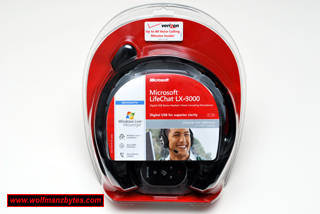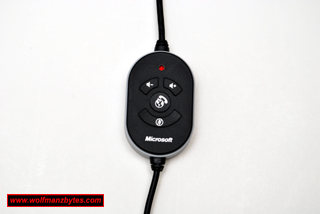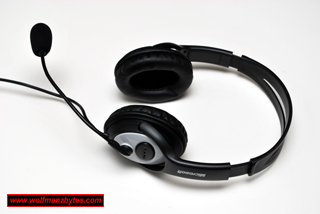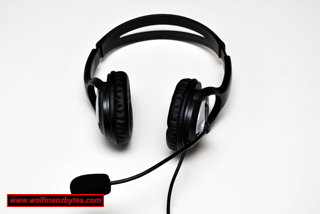
See the Video version of this Review here..
First a big thank you to Microsoft for providing the LifeChat LX-3000 for this Review.
For quite a while now I have been hearing how these USB headsets are better than the standard sound cards and headsets because the USB ones are all digital and there for should be cleaner sounding. Today I compare the LX-3000 to my old Creative Audigy and an analog Logitech headset and see if there is in fact a big difference between the two.
When you unpack the head phones you can see they have the ear cups that cover your ears completely and while this does block out external noises it also makes me sweat. It’s like having a pair of ear muffs on and for me any head phones that completely cover the ears produce the same sweaty results.
The first thing I did just to see what would happen was plug LX-3000 in without installing the software just to see if I could get any audio from them. XP did see the head phones and come up with a dialog box telling me it had detected them but I couldn’t get them to work. I like devices that you just plug in and they work without installing loads of software and clearly these headphones would in fact need software installed in order to work.
So I fired the CD into the drive that come with the Headphones and after a few minutes the software was installed along with a few extra services that were added to the computer as well. These extra services were all for the Lifechat software that makes it so you can answer and place calls with the center button on remote that’s on the chord for the headphones.
After the software installation I noticed on the windows mixer I could select between the LX-3000 and also the Creative Audigy. This allows me to call up either the LX-3000 mixer or the Audigy mixer and make changes. What I was surprised with was the fact the LX-3000 didn’t have anything in the way of adjustments for treble or bass on its mixer. The lack of a treble or bass setting on the mixer means you have to hope that whatever audio program you’re using has treble and bass and you can go into it and adjust those settings.
For me the LX-3000 had way to much bass when playing audio back through the headphones. The fact I couldn’t adjust the bass on the LX-3000 mixer was a bit of a problem. The Audigy sound card does have a treble and bass on its mixer and that’s the way it should be for LX-3000.
The overall sound quality for the audio despite the too much bass was pretty good however I didn’t think it was any better than the audio I get from the analog headphones going through the Audigy.
The picture below is the remote that’s on the chord of the LX-3000, this is used for volume and mute controls along with answering and placing calls with the included software.
Another interesting problem I found was the LX-3000 remote that’s used for turning the volume up and down didn’t want to work on the LX-3000 mixer. When I would turn the audio up or down via the remote the volume slider for the Audigy mixer would be going up and down and not the Volume slider on the LX-3000 mixer. I think the software that controls the volume up and down buttons on the remote was confused by the fact there was an Audigy sound card installed on this machine. I think if you only had the LX-3000 for your primary sound card I don’t think you would have these volume problems at all.
For me the biggest problem with the LX-3000 was the sound of the mic when talking into it. I use teamspeak on a daily basis to talk to friends and when I got on there with the LX-3000 they told me the audio quality was not as good as the other headset I had been using.
So with my friends saying the audio from the headset wasn’t that great I decided to download the sound editor Audacity and hear just how bad the audio was. I set Audacity to grab the audio from the LX-3000 mic and I started to talk away and then I stopped recording and played back the audio. The audio I heard in playback was shocking. It sounded like the audio come from a 1930’s radio broadcast where the audio is way to nasal sounding and lacked any bass.
I also took a look on the Microsoft web site to see if there had been any driver updates for this headset and the driver updates on the web site were the same ones that come on the install CD so no luck there. I was hoping to find an updated driver that added more controls to the LX-3000 mixer.
In conclusion I will be staying with my Audigy sound card and the analog headset. What I would like to see Microsoft do is make a USB headset that doesn’t cover your ears up and also gives great sounding audio from the mic. I would also like to see some treble and bass controls on the LX-3000 mixer. At the time of this Review you could purchase the Microsoft Lifechat LX-3000 USB headset for about $30.00 Canadian.
Below are a few more pictures of the Microsoft LX-3000 enjoy!
WolfManz611..




